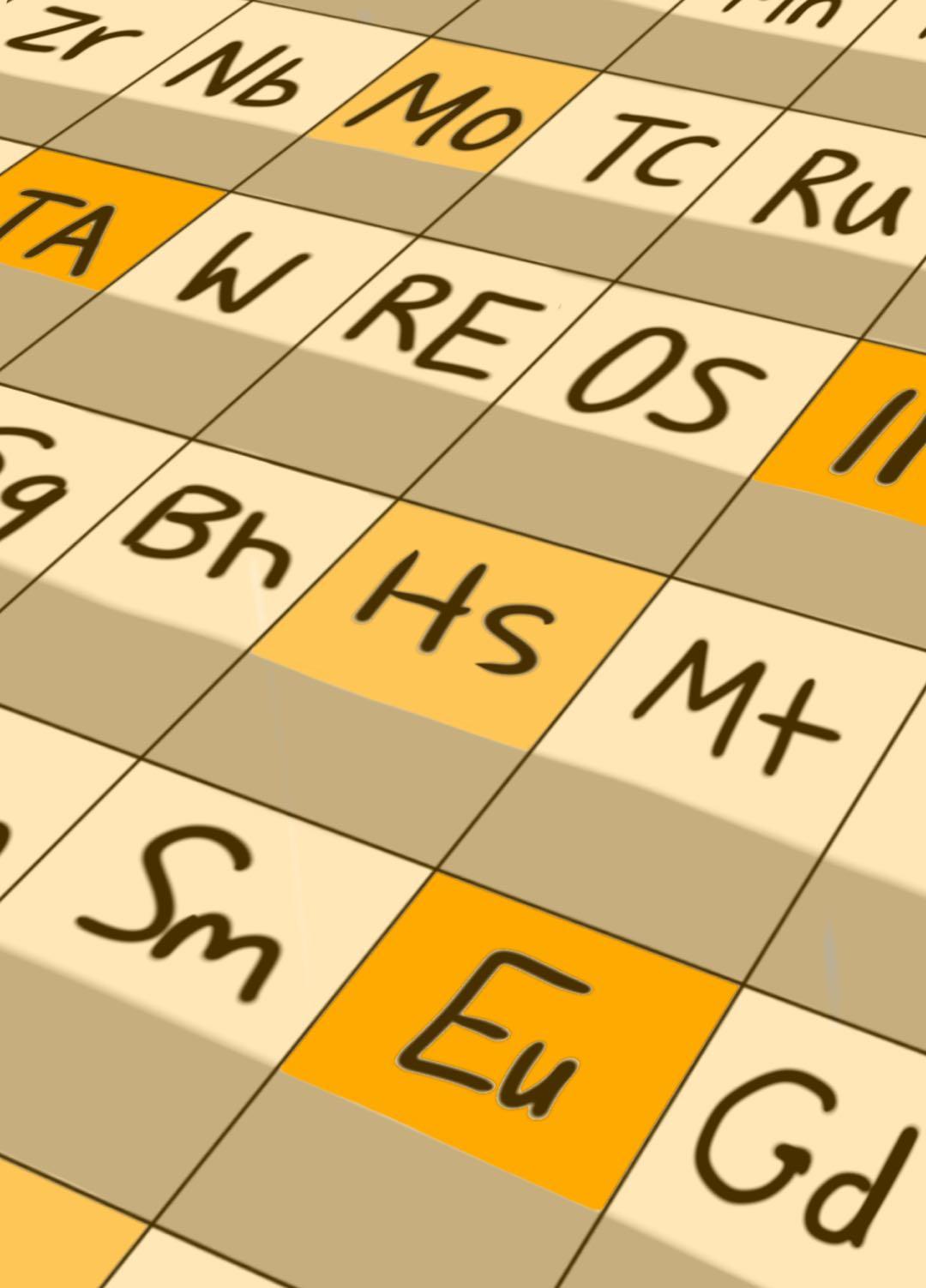HOLIC






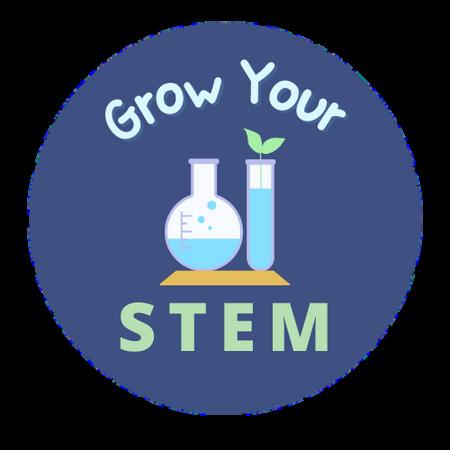
Grow Your STEM is a youth organization dedicated to spreading STEM in our community through growing high schoolers’ interest in STEM & planting seeds of curiosity in young minds. Here at Grow Your STEM, we believe it is crucial for children to be exposed to topics at a young age in a fun, interactive way. Many STEM topics like math and coding are often presented as difficult, challenging topics, even at a young age, which intimidates many people from ever learning more about them. This is why we believe it’s so important to introduce STEM with interesting, engaging activities and easy-to-follow lessons for students!
Littlebiobits aims to educate high-schoolers interested in biology especially biochemistry and biotechnology which are subjects that are not typically explored in school. We aim to do this by creating blog posts on exciting achievements made in the biology field and through social media.


STEM Unites was founded by Riya Mehta and Samir Patel; two passionate university students committed to igniting a love for STEM among younger generations. At STEM Unites, our mission is to empower the next generation with knowledge and inspiration in the world of STEM. We offer comprehensive information, valuable resources, and immersive experiences through engaging events, workshops, and community initiatives. Additionally, we have opened up a general member team so that youth are given an additional opportunity to get involved in these fields, while also earning volunteer hours!

STEM Explorers is an online, non-profit community of curious minds that seek to discover the STEM world. We publish our own articles, publish videos, recommend videos, recommend online readings, conduct written interviews, and recommend events happening worldwide. Our community's goal is to uncover the secrets of STEM and to make them easily available to everyone that may be interested!
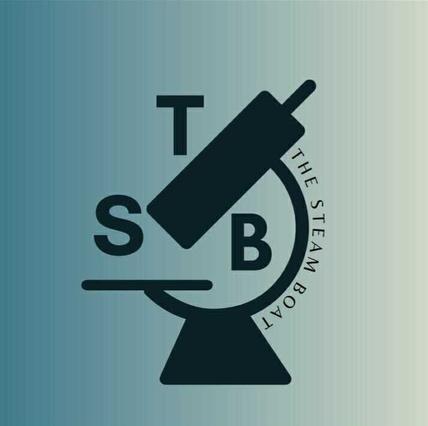


Opportunities_platform is a youth driven community that is created by students on a mission to provide all youths with all tools and opportunities that help them to explore their interest to discover their passion regardless of their family background and finances, this community where you can find top internship opportunities, participate in Hackathons and competitions, do attend workshops by Industry Experts and many more. Which will help you grow and achieve more in the field what your interested in persuing. We help you find the best for you once we know your interests in a field.
The STEAM Boat is a student-run organization full of passion-driven youth doing their part to make a mark on our world. The STEAM Boat is building our future leaders in STEAM fields. We believe that our world would not be the same without STEM and Art working together. We believe that by equipping people with the best tools to solve their own problems, we can tackle the world's problems better, together. We aim to provide the resources students need to succeed in STEAM-related fields.
The STEAM Boat

Our Say on Science is a student-based organization that encourages the celebration of science. Through our informative content, we continue our mission to bring youth closer to the scientific world. We further promote that mission by informing youth about current events in the science community. As our student-run organization is 100% remote, members also learn to communicate well with others and make sure they deliver a clear message.
Our Water Planet is a youth-led non-profit organization that is dedicated to raising awareness and taking action to protect the world's water resources. The organization passionate about preserving the planet's waterways and ecosystems. Our Water Planet's mission is to empower everyone to take an active role in protecting the planet's water resources by providing them with education, resources, and opportunities to get involved in advocacy and action. This is done by focusing on issues such as water pollution, conservation, and access to clean water. Our Water Planet's goal is to inspire and mobilize a generation of young people to become leaders in environmental protection and sustainability.

The Staff of Asclepius (SOA) is a student-run organization that provides students with the opportunity to explore various fields and specialties in healthcare. A core mission of SOA is that students should gain early exposure to different career pathways in order to make a fully informed career decision. Thus, they offer free workshops, webinars, volunteer opportunities, and an annual healthcare conference in order to allow students to network with physicians and researchers within science and healthcare. They provide informational graphics on various healthcare careers, technological developments in healthcare, healthcare history, and opportunities within healthcare to an audience of over 900 students and organizations.
 Our Water Planet
Our Water Planet
Biomed for Youth aims to provide educational opportunities and resources for students in underprivileged communities, specifically through medical and healthcare oriented topics. With our mission to support, engage, and empower, our organization works to open the doors to future career opportunities whilst exploring all that the medical field has to offer. We hope to provide students with hands-on and interactive learning opportunities through engaging workshops that strengthen the next generation of leaders. With our newly published book, educative social media platform, and our website, we strive to enhance existing support for students. Lastly, Biomed for Youth provides competition and experimental-based experiences for High School students and provides funds for school supplies.
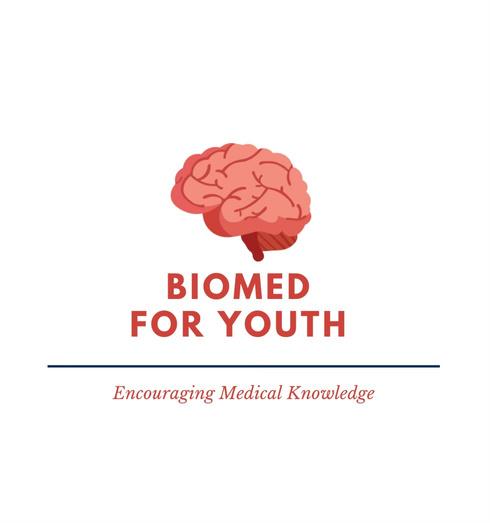
Broncology

Broncology is an international youth-led organization cultivating learning in STEM for people of all ages. We empower students in STEM and provide a platform to cover digestible scientific news. We are also working towards helping learners all over the world at all ages to discover the world of STEM and its intersection with other disciplines through different forms of expression. Broncology strives to make easily understandable STEM information accessible for everyone. We welcome all people from any country speaking any language to join our growing family of STEM. Whatever you have, there is always a space for everyone at Broncology.
 Biomed for Youth
Biomed for Youth


In an era of so much information, it's getting increasingly more challenging yet more accessible to find opportunities. Our mission is to provide ambitious students that are interested in STEM-related fields with STEM opportunities, resources and information, all in one place! Our Instagram @stemsupport_ covers many different fields of STEM, including promoting events such as free webinars, in-person events, learning resources, and conferences such as this one! If you ' re interested in joining our team or catching up on all the amazing opportunities in your area, check out our socials or application posts for more information. We strive to help and guide STEM students towards success!
Opportunities For Students is a global nonprofit platform sharing all competitions,hiring,volunteering ,programs and more opportunities with students. It is also a platform providing students the chance to share tips, communicate ,and find like minded people to bond and initiate their own initiatives. OPPS's mission is to bridge the gap between students and nonprofits, fostering a collaborative environment where young individuals can contribute meaningfully to social causes. Through strategic partnerships with educational institutions and local organizations, OPPS actively connects students with internships, scholarships, and mentorship programs.

Life's Blueprint: DNA, Genes, and the Molecular Basis of Inheritance
Symphony of Slumber: Exploring the Science Behind Sleep and Dream
The Chemistry of Sunscreen: How UV Filters Protect Your Skin

Click Chemistry: Navigating the Frontier of Molecular Bonding
Fizz and Flavor: The Chemistry of Diet Sodas
X-ray Protein Crystallography: Unveiling the Mystery of Atomic Order
Essential Elements: Deciphering the Composition of Vitamins
From Anesthesia to Chemistry: Exploring Chloroform's Medicinal Role
The Biochemistry Behind Love: Neurotransmitters
Unlocking the Mind's Molecules: Neurochemistry
Illuminating Treatment: Radioactive Iodine for Thyroid Disorders
Unraveling Disease Mechanisms and Therapeutic Advances
Vaccine Vials and Molecules: Decoding the Chemistry of COVID-19 Vaccines
I hope this school year has been off to a great start for you! ScienceHolic members have been working tremendously throughout the summer to present amazing articles for y ’all to read. Our Chemistry Themed Magazine is here now!!! Wow Can’t believe this is our seventh edition. Thank you so much for all of your support and patience!
Our articles cover various categories of Chemistry such as Chemical Aspects of Life, Chemistry’s Healing Touch, and many more. We also host a number of conferences and webinars for our readers to view. A lot of cool sessions such as biochemistry where Dr. Nicolai Lehnert talks about chemical processes with living organisms and discusses his career paths and forensic chemistry where Dr. Nicholas Manicke spoke about his research lab that relates to toxicology and all the different drugs and psychoactive substances such as heroin, cocaine, or methamphetamine and how they connect back to chemistry. Feel free to see the highlights of the sessions on our Instagram and also find the recordings of these sessions on our YouTube

Not only that, we are so grateful to all of our partners Without them, we won’t be able to bring these incredible articles to our readers! As always, if you are interested in joining ScienceHolic, feel free to fill out the application on our websites or social media As the weather gets chilly, stay at home and enjoy this edition: A Journey into The World of Chemistry!
Sincerely,
chemical aspects of life
The intricate chemical makeup of DNA serves as life's blueprint from conception to the growth of complex organisms. Deoxyribonucleic acid (DNA) is the key to inheriting traits and defining our health risks, physical characteristics, and behavioral qualities To fully understand the complexity of life itself, one must first comprehend DNA's chemistry and its function in transmitting genetic information.
DNA is a double-stranded, helical molecule made of nucleotides known as the "Molecule of Life." A phosphate group, a deoxyribose sugar molecule, and one of the four nitrogenous bases of adenine (A), cytosine (C), guanine (G), or thymine (T) make up each nucleotide The genetic code, which contains instructions for the creation of proteins and regulates various biological processes, is formed by the arrangement of these nitrogenous bases along the DNA molecule.
Genes are specific DNA segments that contain the instructions needed to create proteins Genes regulate the production of proteins, which are essential to the structure and operation of cells The sequence of nucleotides in each gene determines the arrangement of amino acids in a protein. Variations in characteristics or genetic illnesses can result from mutations
 Author: Spurti Soni Rahat
Author: Spurti Soni Rahat
Editors: Jaylen Peng and Kyra Wang
Artist: Kyra Wang
or changes in the DNA sequence that modify how genes function.
A key process called DNA replication makes sure that genetic information is accurately transmitted from one cell generation to the next. DNA unwinds during cell division, which allows each strand to act as a model for creating a new complementary strand. Following the basepairing regulations (A with T, C with G), DNA polymerases catalyze the addition of nucleotides to create two identical DNA molecules The transmission of genetic information during cell division is made possible by this faithful replication
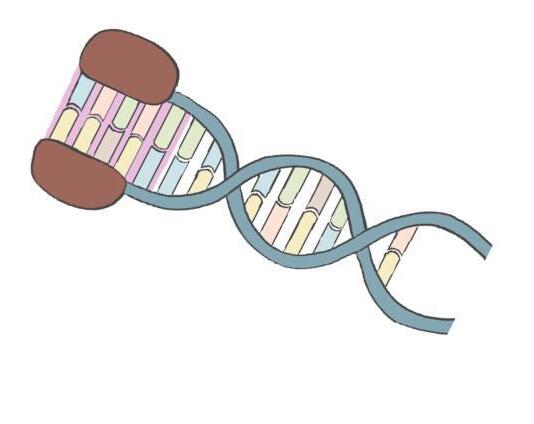
The fundamental principle of molecular biology outlines the transmission of genetic information from DNA to RNA to protein. The process by
which the enzyme RNA polymerase converts the DNA sequence of a gene into a complementary RNA molecule (messenger RNA or mRNA) is known as transcription. Through the process of translation, this mRNA molecule is subsequently converted into a particular order of amino acids, making a protein. DNA and gene regulation mechanisms control the concepts of heredity and genetic variation Each parent contributes half of the genetic makeup of their children in sexually reproducing organisms. Sexual reproduction causes the recombination of genes, resulting in genetic variety and the inheritance of distinctive combinations of features.
chemical aspects of life
 Author: Eshani Sharma
Author: Eshani Sharma
Sleep, despite being so fundamental, can often be challenging to fulfill. Many people are familiar with nights spent tossing and turning, making fruitless attempts to receive a good night’s rest. However, comprehending the scientific intricacies of sleep is even more challenging Yet, a strong understanding is critical since the components of sleep
regulate the many mechanisms that allow our body to rest, recharge, and heal.
A primary component of sleep is sleep/wake homeostasis, which regulates the drive and intensity at which the body feels awake (“Sleep/Wake Cycles”). It controls our body, operating like a timer, where the longer one is awake, the greater the urge the body feels to sleep
Theoretically, the body should be most awake in the morning and feel sluggish by night. However, as we all may know, this is not always the case. Hindering this process is the body's internal clock, the circadian biological rhythm It dictates the body's schedule throughout the day and is responsible for creating periods of sleepiness and wakefulness, as well as the jetlag experienced when traveling across time zones. The suprachiasmatic nucleus is the part of the brain that controls the circadian biological rhythm (Harper). Sensitive to light and darkness, the SCN triggers signals dependent on the outside environment As the day begins and light starts to reach the retinas of the eye, cortisol, and other hormones are released, preparing the body to wake up However,
the opposite of cortisol is melatonin. Though melatonin is commonly known as an over-the-counter pill that induces sleep, it is also a chemical produced in the body. As the night descends, the SCN signals the pineal gland, whose release of melatonin creates a sleepy lull before bed (“Sleep/Wake Cycles”) Alongside melatonin, the chemical adenosine is also critical in facilitating sleep. As it accumulates throughout the day, high concentrations create a sleepy sensation at night (“sleep”). Though the circadian rhythm traditionally works in sync with the external environment, such as light and temperature, it can be disrupted by artificial stimuli like caffeine, which blocks the adenosine receptors, prolonging the “wakefulness” of the body

Sleep is further subdivided into two cycles: Rapid Eye Movement (REM) sleep and Non-REM sleep (“National Institute of Mental Health”) Beginning with stage one of NREM, the body transitions from the wakefulness maintained during the day to a sleepy state as eye movements, heartbeats, and breathing slow down Muscles relax, and the production of low-amplitude mixed frequencies in the brain begins (Lockett). The relaxation of the brain can be attributed to the neurotransmitter GABA, which blocks certain signals in the nervous system, creating a calming effect in the body (Lockett) Though this stage may only last for a few minutes, stage one NREM is crucial to allow for the transition to stage two, which makes up the largest percentage of sleep time. Distinct brain features like sleep spindles and Kcomplexes appear for the first time as the body's temperature drops (Lockett). In stage three of NREM, the body reaches the deepest sleep stage, and eye movements cease as the growth and repair of cells occur (Lockett) Following this is the REM stage, which occurs approximately 90 minutes after falling asleep (“National Institute of Mental Health”). Dopamine has been credited as the main link responsible
for the switch to REM sleep (Hasegawa et al.). REM sleep allows dreams to occur as eye movements become rapid. Breathing, heart rate, and brain activity increase while the muscles are paralyzed The neurotransmitters GABA and glycine are attributed to causing muscle atonia, ensuring that the body remains still throughout sleep and preventing it from acting out dreams (Fraigne et al.). When muscle atonia continues upon waking up, it is known as sleep paralysis, rendering individuals unable to move, usually for a few seconds
The chemical processes behind sleep and dreams have yet to be fully understood But sleep, however confusing and mysterious, remains an essential part of our lives. The implications of sleep science go far beyond providing the body with a recharge. For instance, studies have shown how electrical brain waves during non-REM sleep can contribute to long-term consolidation Experimental trials have documented how sleep deprivation surprisingly alleviates depression among test subjects Unraveling the scientific processes our brains undergo during sleep is critical for aiding in various diseases and expanding our fundamental knowledge of the body.
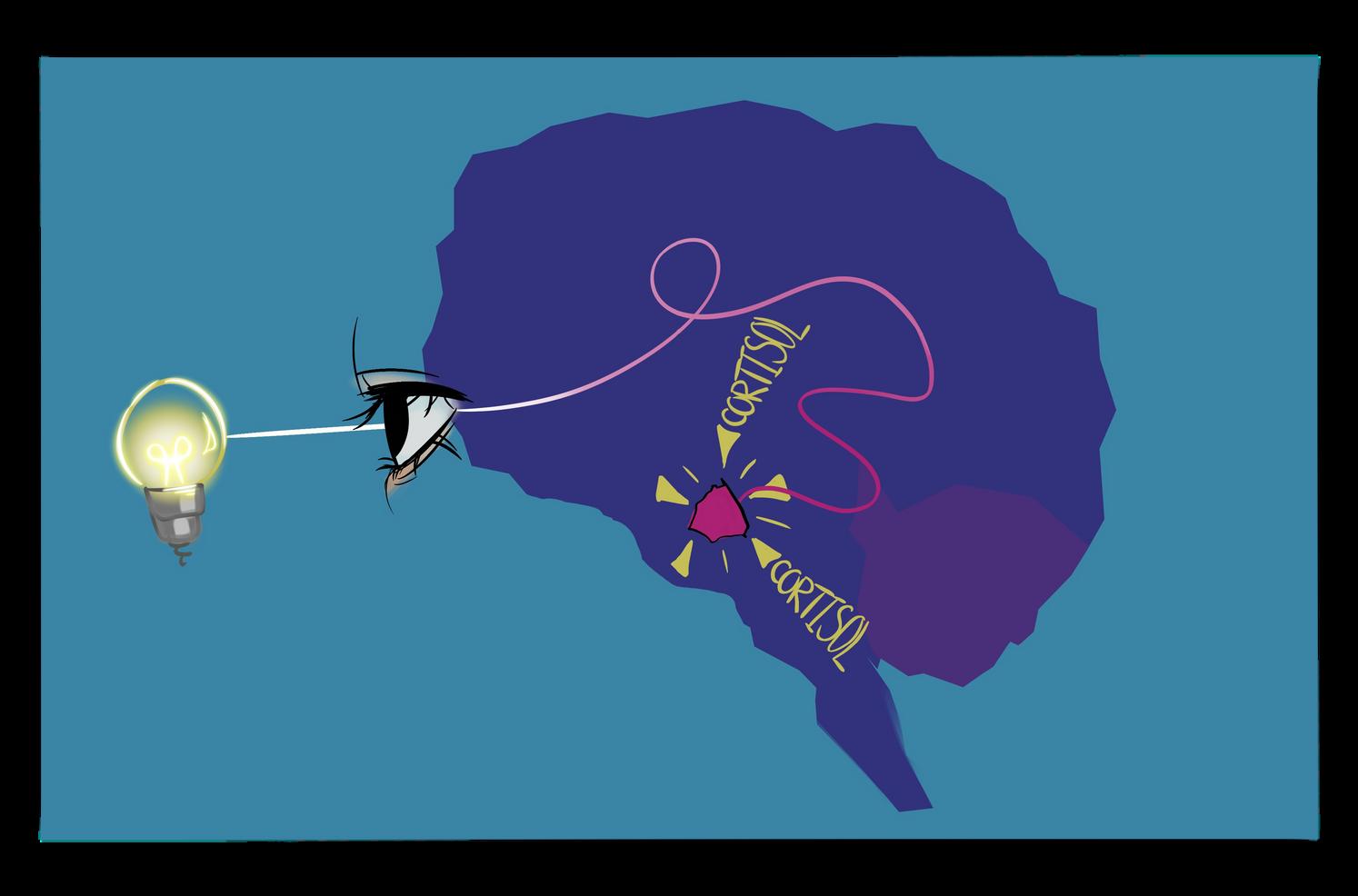
Every time one steps out in the sun, their skin is vulnerable to damage from harmful UV rays Fear not; the ultimate shield to this issue lies in the hands of a sunscreen bottle! To understand how sunscreen works, being mindful of the natural environment is important. Sunlight consists mostly of ultraviolet (UV) rays, invisible or visible. When UV rays encounter skin cells, they disrupt physiological processes or functions. Exposure to UV radiation can cause changes in the body, resulting in slight alterations to the skin and the growth rate of skin cells In the long run, it can result in skin damage, wrinkles, and in severe cases, life-threatening skin cancer. UV radiation that can affect one’s skin is classified into two types: longer UVA rays and shorter UVB rays. Extreme exposure to UVB rays can result in sunburns and damage to the outer layer of the skin, known as the epidermis On the other hand, excessive exposure to UVA rays can cause more serious and permanent damage since these rays can penetrate the thickest layer of the skin, called the dermis. Unlike UVB
rays, UVA rays remain active throughout the year and at any time.
Photosensitivity refers to the skin’s sensitivity to sunlight, which can vary based on age and skin tone. It becomes more difficult for the skin to repair itself as one starts to age Gradually, the underlying connective tissue of the skin can be damaged by UV exposure This results in a breakdown of elastin (skin protein) and leads to wrinkles and lines forming on the skin. Additionally, Skin
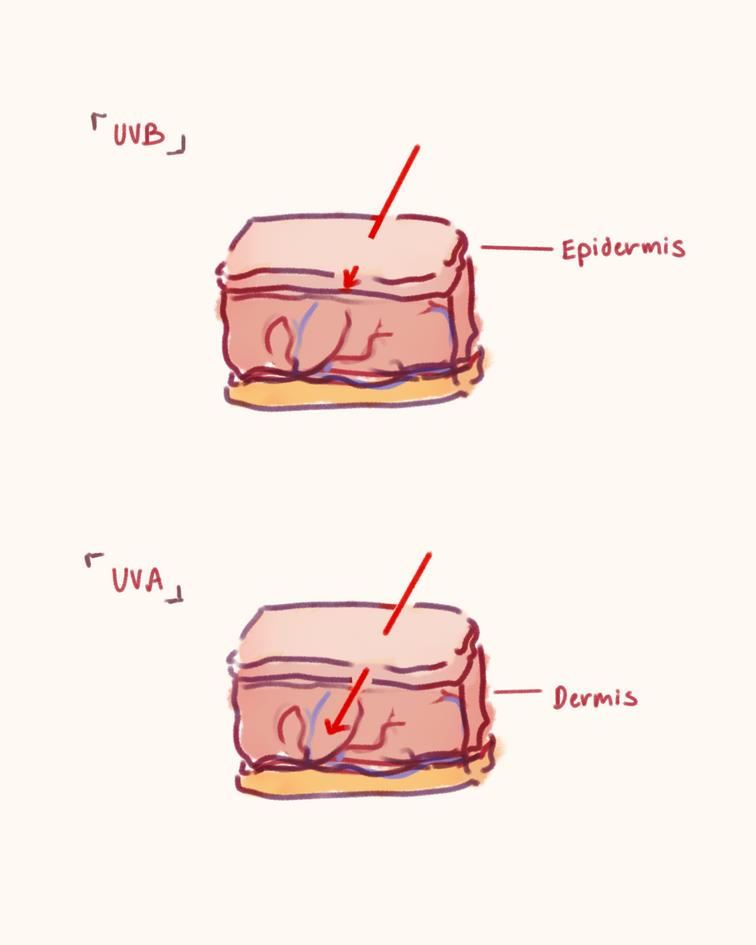
tone plays a significant role in UV sensitivity and the risk of skin cancer

Individuals with fair skin are extremely sensitive to UV light and are prone to burn easily under the sun, while individuals with darker skin pigment are less likely to be sunburnt.
Furthermore, the time of year and climate can determine the chances of sun damage. Understanding the Ultraviolet (UV) Index is crucial for knowing one’s daily exposure to UV radiation, as it ranges from zero (lowest risk of UV radiation) to eleven (highest risk)
Skin protection is essential in climates with an elevated sun damage risk, especially during the hot summer months As well as this, UV rays can still penetrate through clouds, meaning sunscreen should be worn regardless of the weather
Sunscreen combines organic and inorganic ingredients to protect the skin from sun rays. UV filters are chemicals added to sunscreen to absorb or block out UV radiation. Physical sunscreen works as it sits on the surface of the skin (epidermis) and reflects sun rays Often referred to as “mineral sunscreen,” its main active ingredients are zinc oxide and titanium dioxide Physical sunscreen tends to be a better choice for individuals with sensitive skin as the two main ingredients are least likely to cause skin reactions.
On the other hand, chemical sunscreen absorbs UV radiation upon contact with the skin This type of sunscreen contains organic compounds and ingredients such as avobenzone, octinoxate, and oxybenzone These organic compounds catalyze a chemical reaction when sun exposure, converting UV rays into heat, which is then released from the body. Chemical sunscreen is most effective when used during swimming and sports as they have a water-resistant formulation. This type of skin protection is easily absorbed into the skin However, it is ineffective immediately and must be applied at least 20 minutes before sun exposure Furthermore, some of the ingredients may also cause irritation to the skin and should be reapplied often as the protection is used up quickly under UV light.
chemical’s role in health
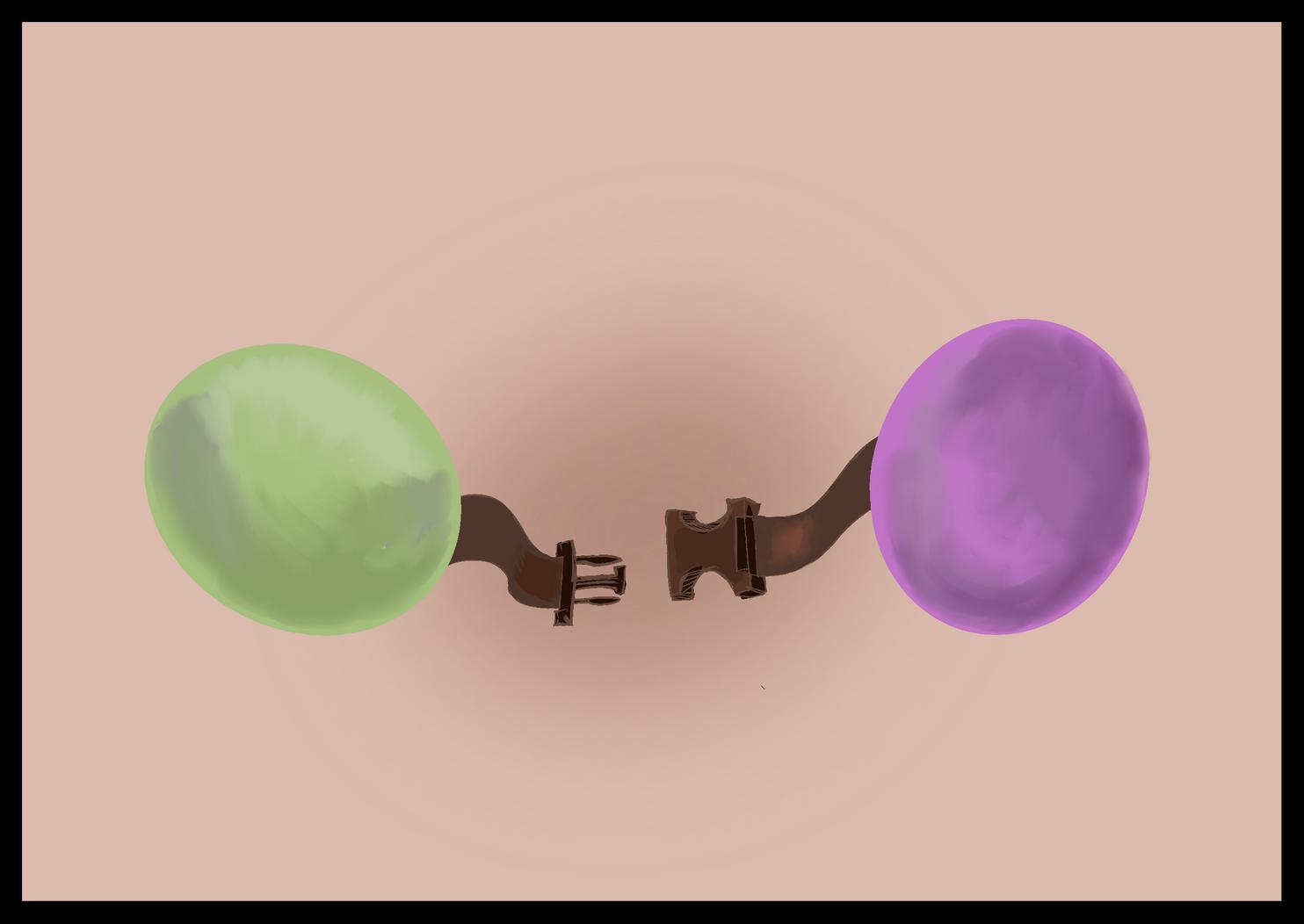 Author: Saebyeok Keum
Author: Saebyeok Keum
Editors:
Ken Saito and Kyra WangArtist: Kyra Wang
Click chemistry, first coined by Karl Barry Sharpless in 2001, was honored with the 2022 Nobel Prize in chemistry alongside bioorthogonal chemistry Its name was given for being as easy and as satisfying as clipping a seatbelt together and serving to convey how connections are made between two blocks of molecules. While it was named more than two decades ago, click chemistry is expanding rapidly as countless reactions and usages are being
discovered. This field has garnered the attention of many because of its efficient and high-yielding reactions and has been a topic of interest to many chemists across various curricula
Reactions in click chemistry, socalled click reactions, occur between two types of organic molecular compounds, called azides and alkynes, with a small amount of copper(I) catalyst to form triazoles. Although this may not seem
different from any other organic reaction, click reactions occur at room temperature, in the open air, with a benign solvent, have high yields, and are highly selective This means click reactions typically give a wanted product in large quantities without requiring elaborate lab setups or special conditions. As the name suggests, it is as simple as clicking two compounds together Click reactions are also highly eco-friendly and result in stable products that do not degrade in physiological conditions Another benefit of these reactions is the ability of the joined molecules to separate on demand which provides an extra level of modularity in molecular manipulation. These traits make click reactions particularly attractive for engineers and scientists who need to th i t i d b t t
but perhaps most prominent is its role in the pharmaceutical industry The ease of synthesis means that chemical libraries with a multitude of compounds can be made quickly, which can expedite the making and testing of new drugs. However, because copper is required as a catalyst, pure click reactions are not suitable to take place inside living organisms. This problem is solved by the use of bioorthogonal chemistry, which eliminates the need for copper and allows click reactions to take place within cells These bio-friendly reactions have an additional upside of not disrupting normal cell function and therefore make perfect candidates for being a biological tracker. Click chemistry is still a burgeoning area of study, and we can expect many more breakthrough discoveries to be made about it Its uses in biomedicine and pharmaceuticals are already far-reaching, and it will be truly exciting to see the full potential of this branch of chemistry
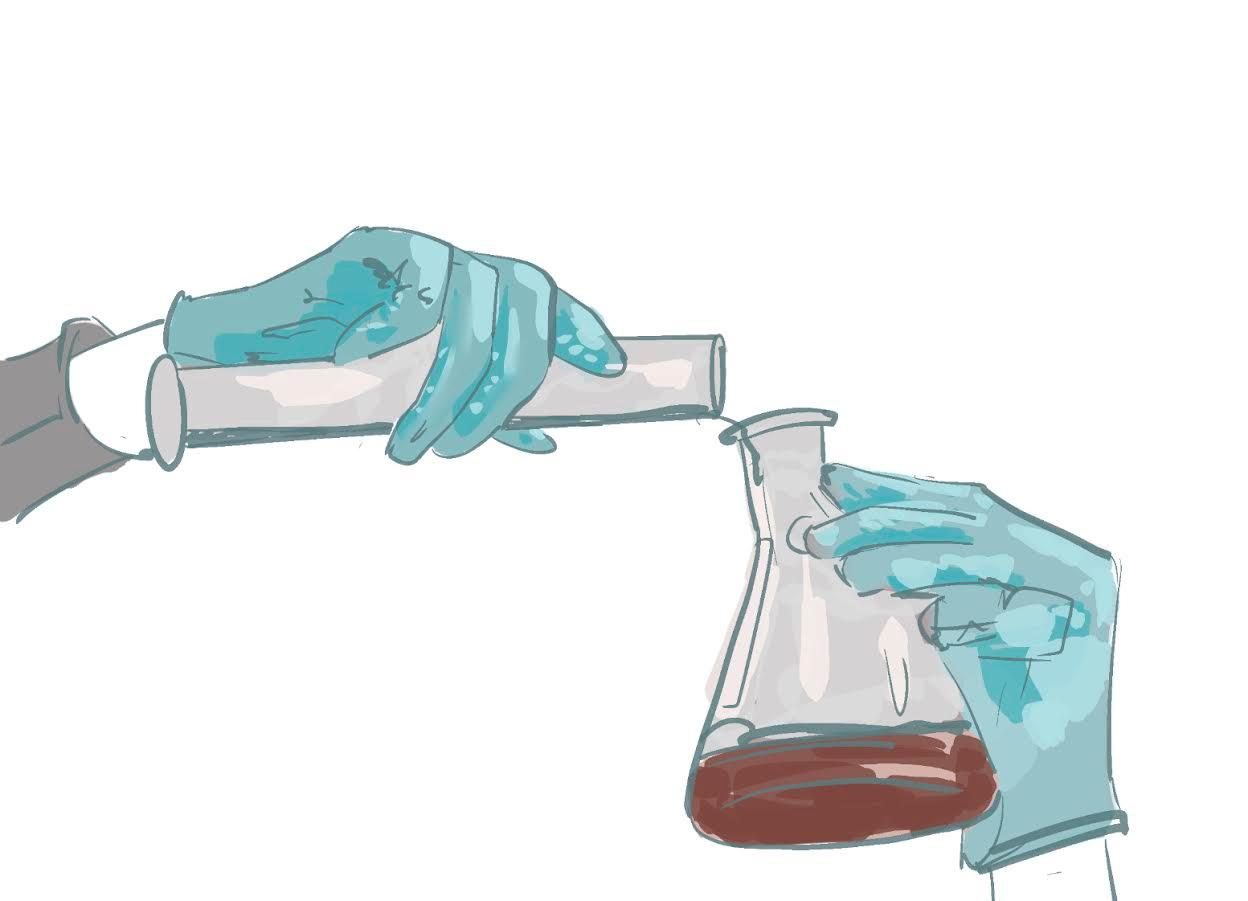
chemical’s role in health
Editor: Angela Pan
Artist: Jenny Luo and Leo Li
Diet soda, known for its refreshing taste in the summer weather and zerocalorie experience, is a top choice for many This drink gained popularity among the diabetic community and fitness role models who sought drinks without calories
Compared to its counterpart (traditional Coca-Cola), diet soda contains no sugar and is promoted as a healthier alternative. Unfortunately, it isn’t really that simple; the lack of sugar is definitely suspicious, especially when it tastes nearly identical to regular soda. Instead of sugar, Diet Coke contains loads of artificial sweeteners, carbonated water, and preservatives, which are linked to various diseases and health
issues. Studies have shown that diet soda can be even more dangerous than regular soda So what is behind the fascinating chemical mixture of diet sodas, and how can something once stressed as a beneficial drink be so misleading?
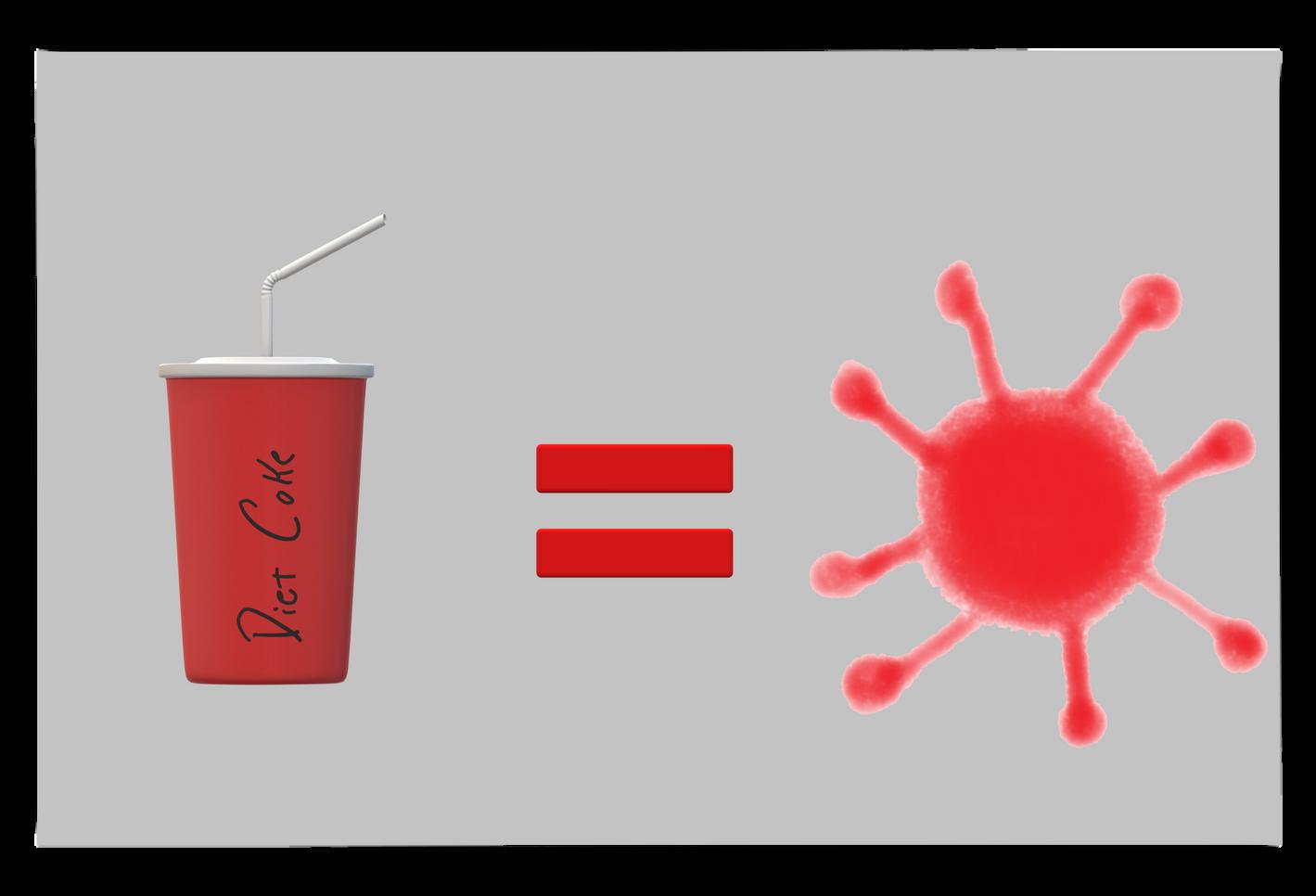
individuals. Instead of sugar, these sodas are artificial sweeteners, mainly aspartame containing the amino acid phenylalanine In the United States, aspartame products must have warning signs about phenylalanine. Individuals with Phenylketonuria (PKU), a genetically inherited disorder in which the body lacks the enzyme that metabolizes phenylalanine, may suffer from brain damage from ingesting this amino acid. Aspartame can cause serious health effects and appetite changes even for PKU-free individuals
Aspartame exceeds table sugar sweetness by 200 fold, which provides sweetness to diet sodas; this can affect the consumer’s taste buds to sweetness, leading to a craving for even sweeter foods and drinks. After aspartame reaches our intestines, it is broken down into aspartic acid, phenylalanine, and methanol. These chemical compounds may affect our neurological pathways; however, the link between these areas is weak In 2008, scientists suggested aspartame’s cancercausing potential, but again, the link is weak and the evidence is limited.

That being said, diet soda’s adverse health effects, such as an increased risk of diabetes, heart disease, bone damage, and dental damage Those unnatural chemicals in diet soda spike blood sugar and insulin levels, which are associated with type-2 diabetes. Heart failure, heart attacks, and strokes are also more likely due to large amounts of diet soda. Moreover, the acidic carbonated water in all sodas contributes to an acidic environment in the mouth. As the pH in the mouth drops, the tooth enamel, a protective layer, can erode over time One major preservative, sodium benzoate, may convert to benzene, a well-known carcinogen, in our bodies
The undeniable truth is that diet soda has very little nutritional value and harms our health. Despite its innocuous advertisement, diet soda’s artificial sweeteners, carbonated water, and acids contribute to major long-term health risks While more scientific research is needed to corroborate the links between regular diet soda consumption and cancer, we can make well-informed choices about what we place in our bodies.
The technique of X-ray protein crystallography is used to ascertain the three-dimensional structures of proteins through the analysis of diffraction patterns. These diffraction patterns are produced when X-rays pass through protein crystals. Through this technique, scientists have been able to further their understanding of proteins’ structures and functions, thus applying this knowledge to various fields Around 100,000 protein structures were
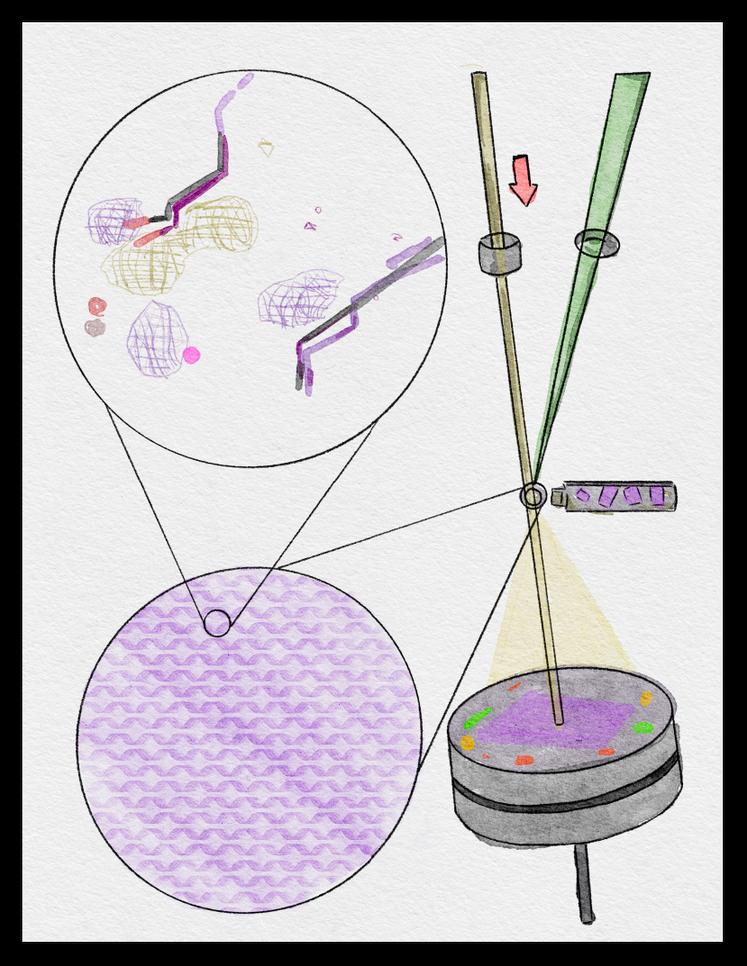
published in the Protein Data Bank this year, and around 10,000 more are added each year
The science of X-ray protein crystallography was first used over a century ago. It was developed by several scientists, mainly Max von Laue, William Henry Bragg, and William Lawrence Bragg, who all worked independently. Max von Laue, a German physicist, discovered in 1912 that X-rays could be diffracted from crystals, deducing the wave-like properties of X-rays He was later awarded the Nobel Prize in Physics in 1914 for this discovery A year after his discoveries, British physicist William Henry Bragg, with the help of his son, William Lawrence Bragg, developed a method to analyze the different patterns produced by the X-rays upon passing through the crystals, consequently forming Bragg’s law. Bragg’s law states that X-rays incident on a crystal’s surface, or its angle of incident, will reflect at the same angle in the scattering This law helped to relate the angle of incidence and diffraction of Xrays to the spacing of the crystal lattice, allowing for the breakthrough of being able to determine the positions of atoms within crystals. Their work was able to
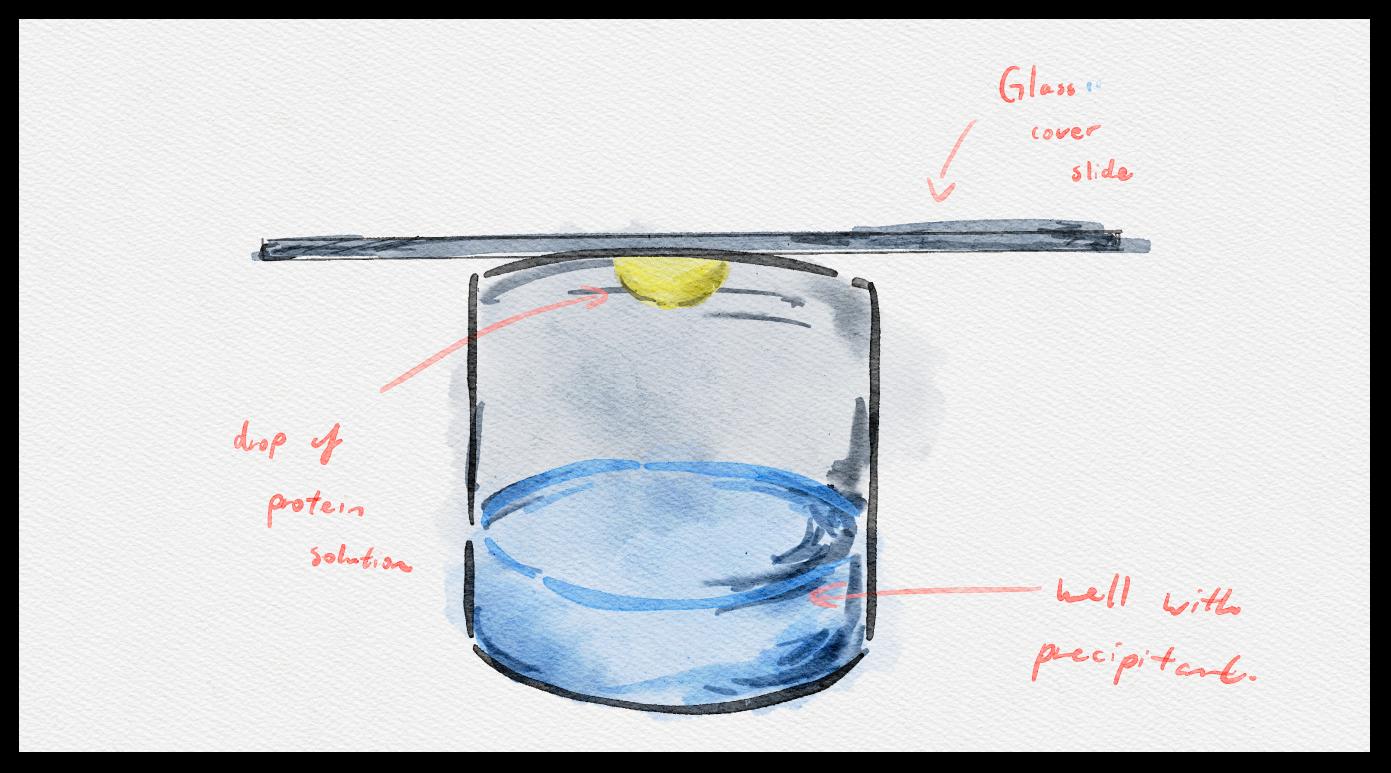
provide fundamental principles for X-ray crystallography, establishing the basis for future studies on the atomic structure of proteins The Braggs later became the first father-son duo to receive a Nobel Prize, one in Physics, in 1915.
This technique relies on X-ray interactions with electron clouds of atoms. When the protein crystals are exposed to the X-ray beams, the beams are diffracted by the crystal lattice, producing a pattern for interference This diffraction pattern holds information about the arrangement of the atoms within the crystal A detector records the pattern produced by the scattered X-rays, with the diffraction pattern being a collection of spots or arcs. The spots and arcs’ intensities and positions provide information about the atom arrangements inside the crystal.
X-ray protein crystallography continues to be utilized in a broad range of applications to study protein structure,
For instance, it is used in drug discovery and design The technique determines a protein's structure, which helps identify various potential binding sites for small molecules. It is used to study protein-ligand interactions, help develop new drugs, and design more effective therapeutics. It is also being used in vaccine development to gain more insight into the function and structure of viral proteins, which are targets for vaccine design Through all the knowledge gained about how viral proteins interact and assemble, scientists can determine the optimal composition and presentation of viral antigens. This being used to formulate vaccines and enable them to optimize their immune response allows for more effective vaccines against viral diseases, making X-ray protein crystallography an important technique to ensure our safety in the future
Vitamins, along with minerals, are essential for body growth and health
However, the human body doesn’t produce these naturally, so we receive them through food The average person doesn’t need extra vitamins, but often due to sickness or medical conditions, supplemental vitamins are taken. For example, we often hear about vitamin D deficiency, which happens when people have an inadequate amount of sunlight exposure. Another example would
be scurvy, a disease caused by vitamin C deficiency. The proper vitamin dosage is recommended to ensure a healthy growing body and regulate hormones
There are 13 essential vitamins: A, C, D, E, K, and B, which include thiamine, riboflavin, niacin, pantothenic acid, biotin, B6, B12, and folate. These vitamins can be classified into two categories, fat-soluble and water-soluble vitamins. Fat-soluble vitamins, including vitamins A, D, E, and K, dissolve in fats and are stored in the
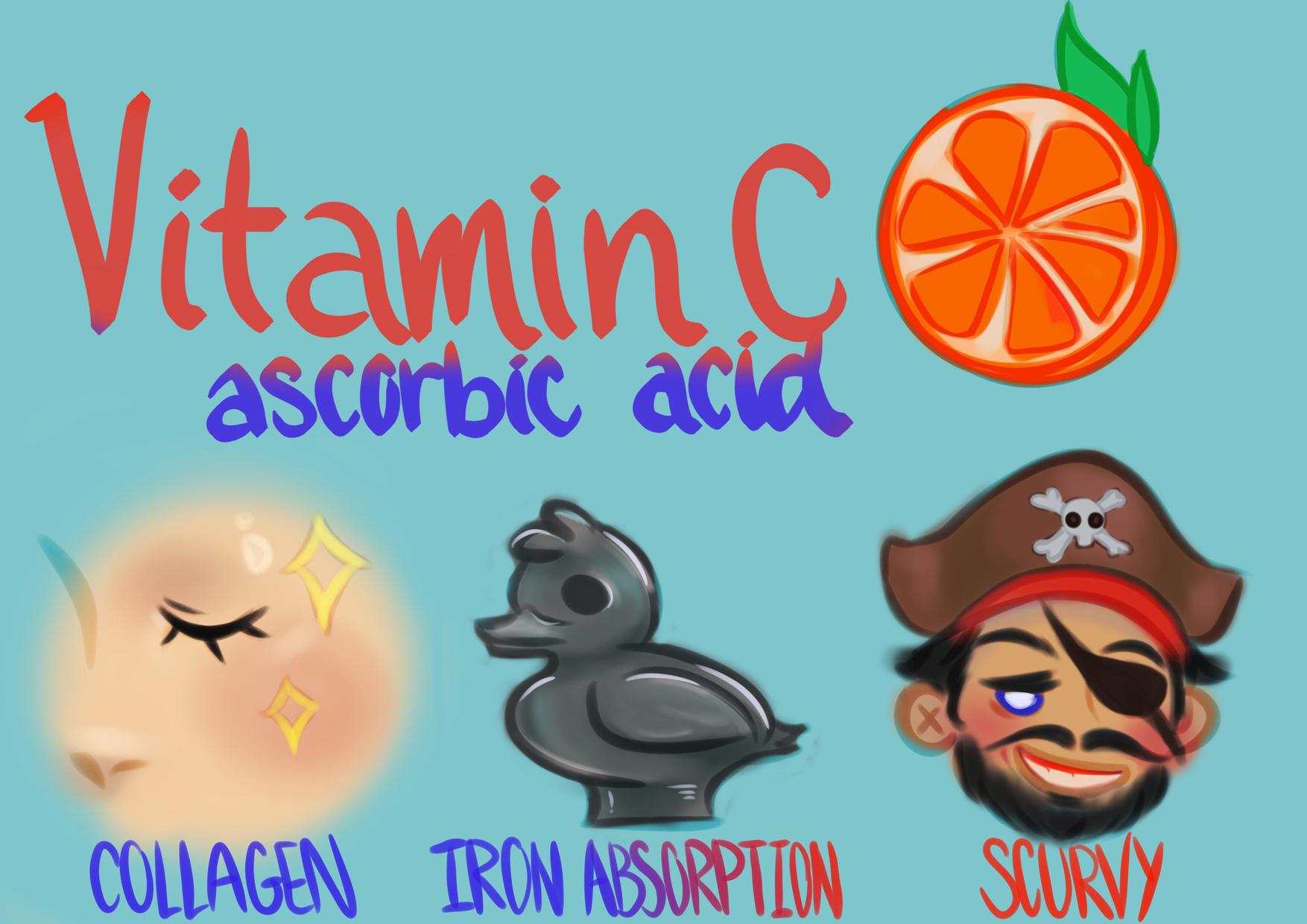
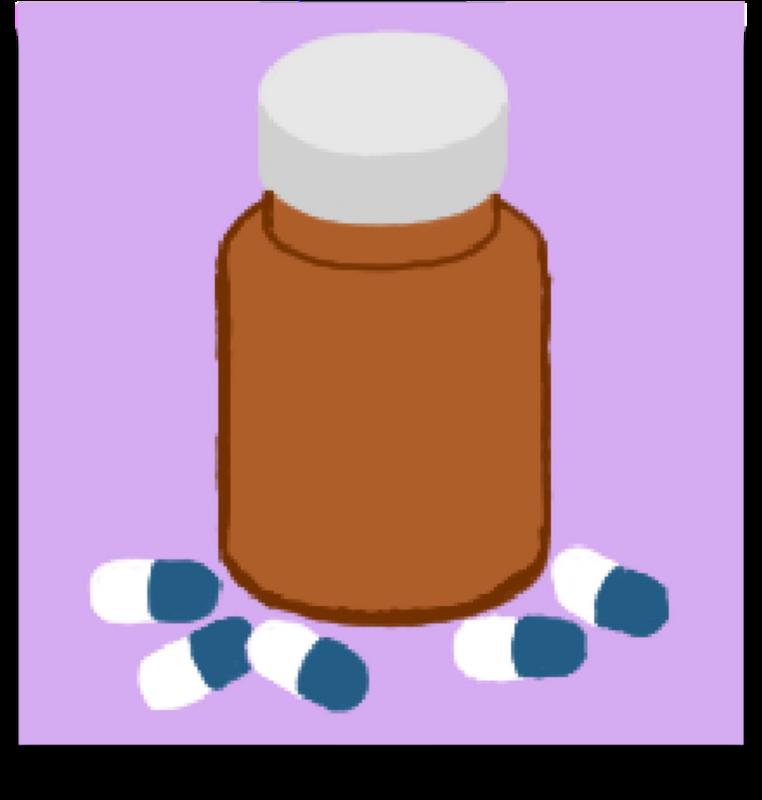
body, whereas water-soluble vitamins, such as B vitamins and vitamin C, dissolve in water and are not stored in the body This means the body stores fat-soluble vitamins more easily and requires less regular intake than water-soluble ones
Vitamin A exists in several forms, including retinol, retinal, and retinoic acid. Your body absorbs some carotenoids, or pigments that give color to yellow, orange, and red fruits and vegetables, converting them into vitamin A Vitamin A is essential for normal vision, the immune system, reproduction, and growth and development
Vitamin D is available in vitamin D2 (ergocalciferol) and vitamin D3 (cholecalciferol). Vitamin D3 is synthesized in the skin when exposed to sunlight, while vitamin D2 is obtained from plant sources. Vitamin D is aids in calcium absorption, essential for bone health It protects against osteoporosis, a disease that weakens bones
Vitamin E encompasses a group of various compounds, including alphatocopherol, beta-tocopherol, gammatocopherol, and delta-tocopherol. These fat-soluble antioxidants protect cells from free radicals (compounds formed when the body transforms food into energy). Vitamin E prevents blood clots by widening blood vessels and boosting the immune system, promoting vascular health
Vitamin K has two known forms; K1, or phylloquinone, is found in plant sources like leafy greens, while K2 (menaquinone) is produced in the intestinal system through bacteria and is also present in fermented foods. Vitamin K helps prevent blood clotting, reinforces bone health, and reduces blood thinning from the warfarin dose
Vitamin B1, also known as thiamin, is a water-soluble vitamin that functions as a coenzyme in energy metabolism Its chemical structure consists of thiazole and pyrimidine rings It involves converting food into energy and possible links to diabetes, heart failure, and Alzheimer's.
Vitamin B2, or riboflavin, is an essential component of two major coenzymes: flavin mononucleotide (riboflavin-5-phosphate, or FMN) and flavin adenine dinucleotide (FAD) These play a crucial role in energy production, growth, and maintenance of tissues, as well as antioxidant defenses
Vitamin B3 (Niacin) is the general name for nicotinic acid (pyridine-3carboxylic acid) or nicotinamide (niacinamide or pyridine-3-carboxamide). It is absorbed into its main metabolically active form within tissues as a nicotinamide adenine dinucleotide (NAD) coenzyme NAD is a catalyst in over 400 reactions in the body, helping absorb energy transformed from food
Vitamin B5, or pantothenic acid, is a coenzyme A (CoA) component, which is used in fatty acid synthesis and degradation, the transfer of acetyl and acyl groups, and other metabolic reactions Its function is similar to that of other B vitamins, but it breaks down fatty tissue.
Vitamin B6 is a generic name for six compounds: pyridoxine, an alcohol; pyridoxal, an aldehyde; pyridoxamine, which contains an amino group; and their respective 5’-phosphate esters. B6 is especially important for brain development during pregnancy and infancy and immune function
Vitamin B7 (Biotin) is a cofactor for 5 carboxylases (propionyl-CoA carboxylase, pyruvate carboxylase, methylcrotonyl-CoA carboxylase [MCC], acetyl-CoA carboxylase 1, and acetyl-CoA carboxylase 2). These carboxylases catalyze reactions that metabolize fatty acids, glucose, and amino acids It’s often used in hair, nail, and skin products to strengthen cells

Vitamin B9, or folate, refers to a group of compounds, including folic acid (in the form added to food) It functions as a coenzyme in single-carbon transfers in nucleic acid synthesis, such as DNA It helps replicate genetic material and allows the cells to divide properly. Folate is essential during pregnancy for proper fetal development.
Vitamin B12 itself contains cobalt, so compounds with B12 activity are often called cobalamins. It has two metabolically active forms: methylcobalamin and 5deoxy adenosylcobalamin B12 is important in various contexts, including the development and function of the central nervous system, healthy red blood cell formation, and DNA synthesis.
Vitamin C, or ascorbic acid, is special because the human body cannot synthesize it, so it is a must-have in a diet. It is a water-soluble antioxidant that protects cells from damage, aids collagen synthesis, enhances iron absorption, and supports immune function It is found in various fruits and vegetables, so many eat oranges to cure scurvy
In some way, shape, or form, vitamins are (you guessed it) vital to proper human functionality. Not only do vitamins help us produce essential enzymes and catalyze much-needed reactions, but they also protect us from many diseases and prevent our bodies from breaking down However, there is a proper dosage for all vitamins, and one should refrain from consuming supplemental vitamin gummies or pills on a whim. The proper nutrients are important for the body to grow, so ensure all vitamin needs are met.
Chloroform has a very negative reputation in modern-day society, whether used as a prop to render many unconscious in police procedural shows or as a comedy tool in TV shows like Community. However, due to safety concerns, chloroform itself was discovered to replace ether as an anesthetic Chloroform, also known as CHCl3, is a colorless liquid with a very pleasant odor and is categorized as an acute toxic health hazard by the
Datasheet. The chloroform story is rich with medicine, chemistry, and death. In this article, we will explore chloroform’s discovery, chemistry, extraction from the body, and medical history.

Although chloroform was discovered by a German pharmacist named Moldenhawer in 1830, James Young Simpson pioneered its usage in surgery and in America on November 4th, 1847, with
Author: Manogna Bedhu
Editor: Hwi-On Lee
Artist: Tracy Xu
his assistants. Why was it created? During this time, the primary anesthetic used by physicians during childbirth and other surgeries in the 1800s was ether Ether while being a passable anesthetic worked incredibly slow More importantly, Ether is highly flammable, and most physicians worked by candlelight, making it even more of a hazard in the room. James Young Simpson had previously tried acetone and benzene with no luck. Then, he poured the chloroform into a bowl and inhaled the vapors with his assistants. Within 2 minutes, he and his assistants had dropped to the floor, unconscious Once they had woken up, Simpson immediately began promoting chloroform as the newest solution to the previous anesthesia problem.
With a sweet, fruity smell, chloroform is created artificially through chlorination and is naturally found in some seaweed, fungi, and abiotic soil processes. However, how it works as an anesthetic is still a mystery One potential method considered by modern scientists is that it affects the potassium ions in nerve cells and stops pain mechanisms by disrupting the cell membrane. However, these are just theories.
While the initial purpose of chloroform was an innocent anesthetic, its widespread availability across the United States during the 19th and 20th centuries led to it being used as a tool for murder Interestingly, the method used to detect chloroform in a deceased member by a toxicologist relied heavily on chemistry
As previously mentioned, chloroform is a colorless liquid formed from one carbon, one hydrogen, and three chlorines, making
its nonpolar 3-D chemical structure a tetrahedron. To separate the chlorine from the patient’s body, affected tissue would be steamed and combined with a destructive element such as an acid Otherwise, it would be combined with lye and benzene, rendering the tissue yellow-red if there was indeed chloroform
Chloroform often killed patients, which can be observed by the fact that toxicologists developed at least 2 methods for its detection. However, it was equally as much of a loose cannon when used as an anesthetic According to The Poisoner’s Handbook, 1 in 3000 would die seemingly out of nowhere when undergoing surgery However, there did not seem to be a correct dosage either, as an addict could take a quart but still move. At the same time, just a third of a teaspoon could sometimes kill a healthy adult due to its volatility and the emergence of better anesthetics as technology developed, organizations such as the American Health Association pushed this compound out of pharmacies However, the use of chloroform is very much alive to this day as it is used in refrigerants, solvents, and chemical manufacturing.

With the summer in full swing after AP week, I always have this tradition of binge-watching K-dramas all day to celebrate. This time around, it’s a medical drama named “Hospital Playlist,” which is about a group of doctors working at the same hospital. Like many other K-dramas, the romance between the characters is toptier The best thing about it is how the love between the characters builds as you progress from episode to episode, and that got me thinking what causes us to fall head over heels for someone?
Author: Ted IsidorEditor: Hwi-On Lee
Artist: Carys Chan
Now in order to begin investigating what part of our body causes us to fall madly in love, the first area we must analyze is our brain. In a basic biology class, we are taught that our brain consists of four lobes, the cerebellum, the brain stem, and several other parts to carry out the necessary processes to function. Now, when it comes to our emotions, hormones play a big role We have all heard about hormones, but to discuss how they relate to chemistry and love, it’s good first to understand the key phrase used to describe

hormones: our body’s chemical messengers (MedlinePlus) These chemical messengers travel through our bloodstream and have multiple functions, including growth and metabolism The brain is the factory that produces hormones, specifically the glands and the hypothalamus. Since love is an emotion and hormones play a significant role in how we feel, it is vital to understand how these work in tandem. Let’s dive deeper into the connection between the two

perspective, the chemical that arises when you smell a nice batch of cookies is the same chemical that your brain produces when you see the face of someone you love Dopamine holds significance in our search for understanding love as it is why we get that sense of euphoria when we are deeply in love with someone. Additionally, the same article reveals that specific chemicals can be associated with specific emotions associated with love. One such chemical is oxytocin, which is referred to as the cuddle hormone Oxytocin is a unique hormone that affects our body in multiple ways In a Live Science article, it is mentioned that oxytocin plays a pivotal role in pregnancies and maternal bonding. Now that it is understood how fundamental hormones are to love, it's also important to note how an excess of these hormones can produce negative effects.
When you love someone, multiple parts of your brain are at work to produce this feeling A contributing factor to this stimulation is the chemical elements found in your brain For example, an article released by Harvard Medical School revealed that dopamine, the feel-good chemical, is prominent in certain parts of the brain when people see a photo of someone they love. To put this in
Love is a powerful emotion, and although it’s beautiful, it can also be dangerous As stated earlier, love triggers a release of large amounts of dopamine, which can be an issue since many addictions that people suffer from also cause the brain to release large amounts of dopamine. In an article by Medical News Today, they discussed how rejection can result in certain individuals exhibiting behaviors that activate parts of the brain similar to how a cocaine addiction would This sounds quite bizarre, but it is true and it goes to show how powerful love can be and how chemistry plays a big role in all of this. Love is beautiful and so is chemistry and it’s interesting to study how both subjects intertwine. Thus, I hope you were able to admire this interesting connection as you read along.
Artist: Leo Li
Neurochemistry: the study of the nervous system’s components, chemical structure, reactions, and overall composition (MESH-NCBI)
Neuroscience: the study of how the nervous system evolved, structured, and works (Mind-Brain).
Curiosity about the brain can date back to 400 B C in Circa, Greece, when Hippocrates and Aristotle were debating what the function of the cranial organ was.
When thinking about the brain’s purpose, Aristotle proposed that it cooled the blood whilst the heart was the center of intelligence, which would later be proven incorrect. Hippocrates correctly proposed that the brain was the center of intelligence, sensation, and perception He also realized that during epilepsy, the brain was the organ being disrupted, which modern science has proven true

As technology and science progressed, different specialists became interested in evaluating the brain. Physiologists, Psychologists, Biologists, Biochemists, Organic Chemists, and Pathologists, to name a few The term neurochemistry originated from the term
“Nervenchemie,” coined by the “pioneer of physiological chemistry” Julius Eugen Schlossberger The pioneer wrote specifically about the “chemical nature of nervous tissue,” specifically referring to the organic and inorganic properties of the body’s “central and peripheral nervous tissue. In the brain, two types of tissues present as gray and white matter. The gray matter comprises neuronal cell bodies, primarily of areas such as the cerebellum and cerebral cortex White matter, on the other hand, is composed of “bundles of axons,” meaning a neural structure coated with proteins and lipids, or protective myelin, that help “conduct nerve signals” and processes throughout the spinal cord. Schlossnerger found that gray matter's metabolic processes are greater than white matter's
However, the chemist who is often referred to as ‘the father of neurochemistry’ is Johann Ludwig Wilhelm Thudichum because he was the first to not only investigate the brain but also to apply his work for an “extended period” of time. Thudichum described how the brain had the most varied chemical composition of the body compared to other nerve-depending organs
Thudichum also hypothesized that alcohol and morphine were sources of toxins affecting or being produced by the brain, or these were being carried to the brain The first publication regarding a unique substance in the brain, phosphorus, was made in 1719 by physician and professor Johannes Thoms Hensing in Germany. Hensing was a physician and professor of Natural and Chemical Philosophy, though his findings were not considered at the time. However, this makes sense as phosphorus is in the brain’s phospholipids
In 1937, American chemist Irvine Page published the first ‘neurochemical’ textbook, Chemistry of the Brain, about a topic not extensively researched: general metabolic pathways in nervous tissues. However, Page did notice that the brain's chemical composition did vary, meaning there are different signals or functions within the organ. This led two scientists, Cécile and Oskar Vogt, to investigate the basal ganglia or the portion of the brain that primarily controls motor functions and other functions such as learning, emotion, and behaviors The Vogt experimented with “electrical stimulation of the exposed cerebral cortex” and determined that different outer regions of the brain had
unique functional responses depending on the distinct structure. The area of research is now called functional brain mapping or brain imaging.
Technologies used to track neuron activities are single-cell recording, ECoG (electroencephalography), and MEA (multielectrode array) Single-cell recording is an invasive technology that targets a singular neuron in a subject’s brain By placing charged electrodes around or in the center of a neuron, the cell's firing is tracked and then translated into spikes for analysis. Usually, this technology is used for patients with epilepsy or other neurological conditions. Similarly, electroencephalography is an invasive technology that is put on an epileptic patient's “exposed surface of the cortex” to detect which part of the brain causes the seizures for surgical removal Technological advances in neuroscience are always occurring and are important as the field moves forward.
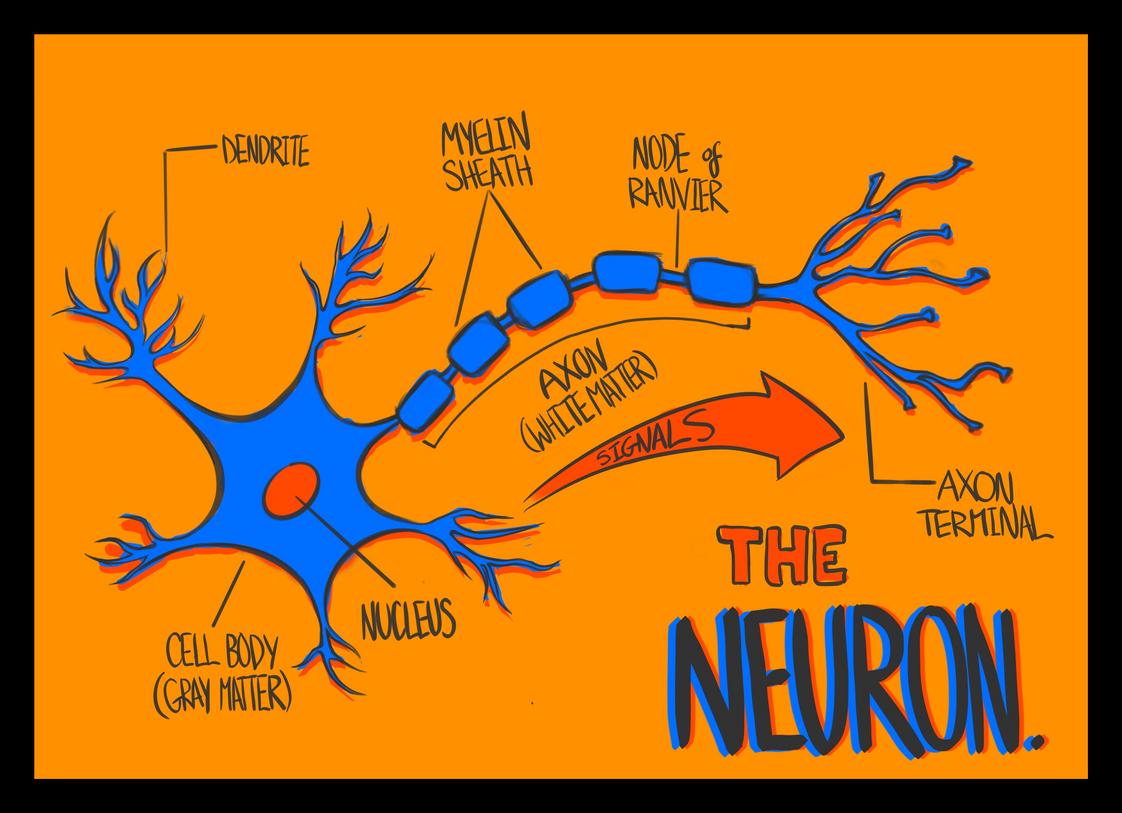
Human curiosity is a never-ending venture; from Hippocrates to psychiatrists, and organic chemists, neuroscience touches all fields where the brain and its structure or function are concerned While the brain may seem a simple organ, centuries of scientific discovery have proven quite the opposite.
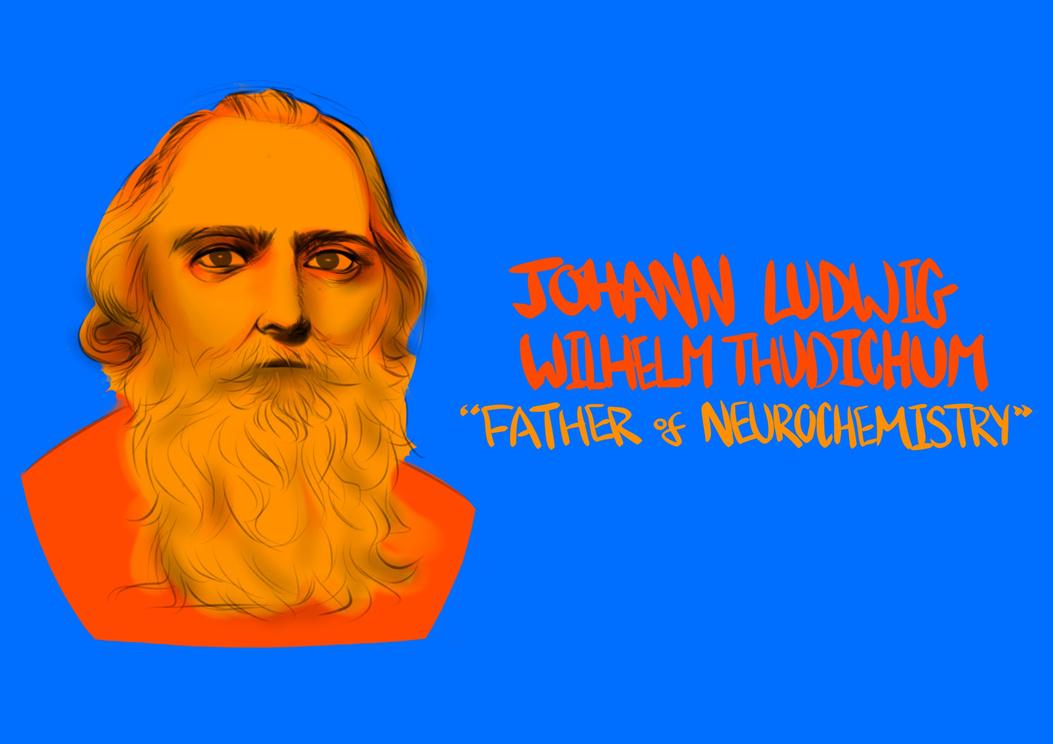
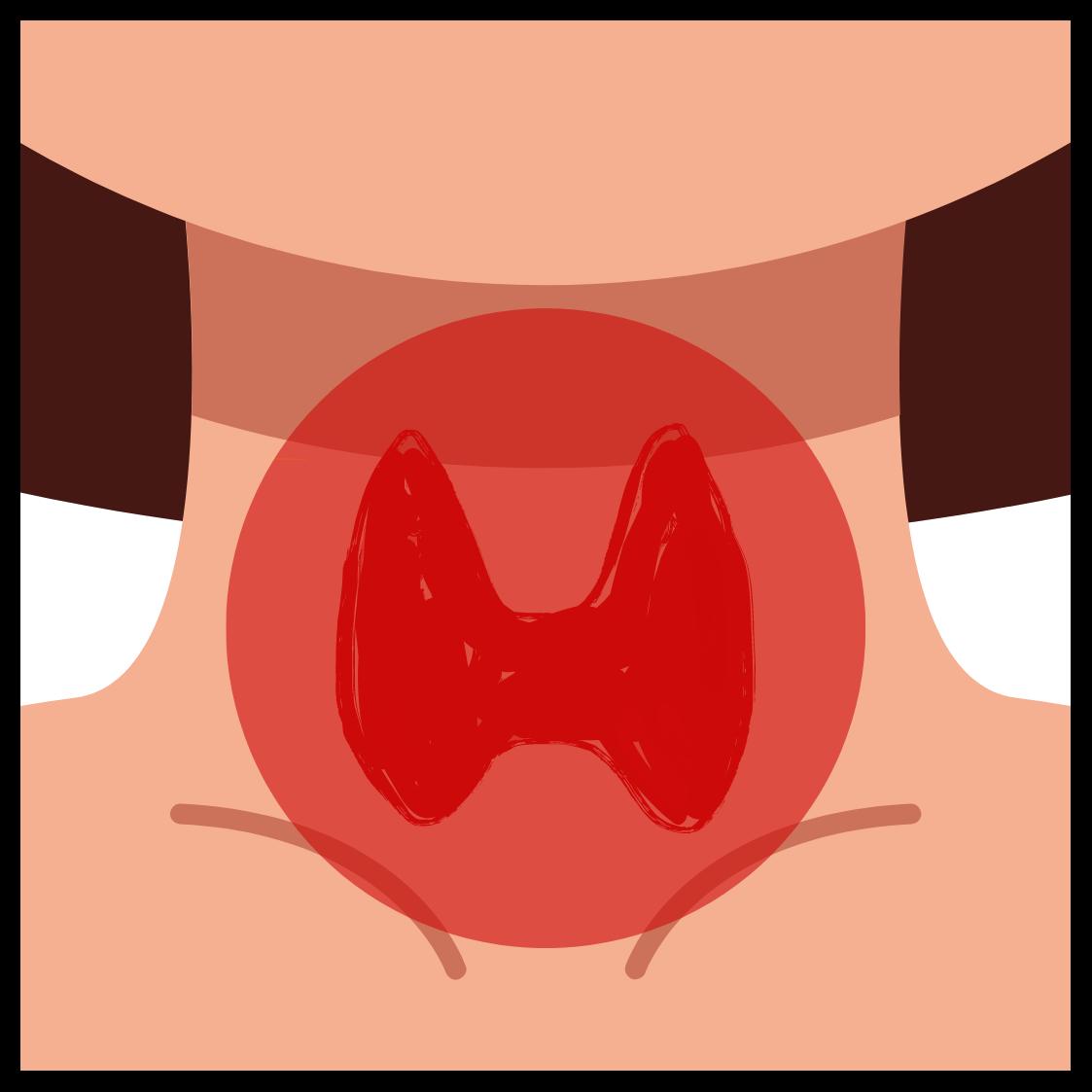 Author: Emma Wen
Editor: Hwi-On Lee
Author: Emma Wen
Editor: Hwi-On Lee
Artist: Jenny Luo
At first, radioactive substances may seem dangerous and best avoided at all costs However, I-131, an isotope of Iodine, has challenged this notion by demonstrating its capabilities in treating thyroid diseases, including hypothyroidism, Grave’s disease, and thyroid cancer.
The development of I-131 as a treatment dates back to several monumental studies Karl Compton and the
thyroid group at Massachusetts General Hospital conducted a study that resulted in the creation of I-128; however, the 25minute half-life of I-128 was too short to be used for diagnosing and treating thyroid disease. This led to the creation of I-131, which has a half-life of 8 days, and I-130, which has a half-life of 12.5 hours. In 1938, Hertz, Roberts, and Evans tested radioactive iodine on thyroid function in animals in Boston and Hamilton and Soley
in San Francisco I-131 emerged as a viable option as it behaves chemically and physiologically the same as I-127, a stable isotope of Iodine. In other words, the thyroid glands would take in the radioactive iodine in the same manner as stable iodine, allowing the treatment to be easily accepted by the glands. However, using I-131 as a thyroid treatment required a significant amount of trial and error
Grave’s disease was the first thyroid disease treated with radioactive iodine The usage of I-131 was much better than other anti-thyroid drug treatments, providing shorter healing times and less chance of death and complications. In 1949, a patient with metastatic thyroid cancer considered 100% fatal at the time could return to full health after radioactive iodine treatment Diagnosing hyperthyroidism is more accurate when using I-131 than other diagnostic methods, such as cholesterol, and treatment with I-131 is capable of helping patients regain normal thyroid gland function.
This practice has become increasingly common, with I-131 often being prescribed to patients to help with thyroid diseases.
Once administered to a thyroid cancer patient, I-131 circulates through the individual’s bloodstream and is eventually absorbed by the thyroid cells. Iodine is easily absorbed because it is an essential component for the thyroid to produce thyroid hormones, providing it with a mechanism to concentrate the circulating iodine The treatment selectively affects the thyroid cells, leaving other cells unaffected, and the radiation in I-131 effectively kills the targeted thyroid cells
Despite the significant advancements in treating thyroid diseases with radioactive iodine, there are still flaws. Iodine-resistant cancers pose a significant problem for relapsing thyroid cancer patients, as I-131 becomes ineffective, and finding new treatments is often hard to find Moreover, radioactive iodine treatment rarely improves survival or relapse rates of differentiated thyroid cancer patients While the understanding of the chemistry behind radioactive substances has been able to improve the treatment of thyroid diseases substantially, further research is needed to address these limitations and develop more effective treatments

chemistry’s healing touch
Among the most cherished possessions of humanity are health and happiness. Through the ages, we have made enormous progress in comprehending the complex mechanisms behind diseases and creating cutting-edge therapies to combat them The discipline of medicinal chemistry is at the forefront of these advancements Through the lens of this field, researchers probe deeply into the molecular world, unraveling the causes of disease and opening the door to groundbreaking therapeutic approaches. In this piece, we delve into the intriguing field of medicinal chemistry and how it has
transformed healthcare.
A thorough understanding of the underlying causes and mechanisms of diseases is provided by medicinal chemistry. Scientists learn a lot about the complexities of the interactions between molecules in the human body, which helps them better understand how different diseases start and progress For instance, researchers have made important strides in understanding cancer, neurological diseases, and genetic abnormalities using chemical methods.
The Human Genome Project was a significant development in medicinal
 Author: Spurti Soni Rahat
Author: Spurti Soni Rahat
Editor: Sophia Chen and Ken Saito
Artist: Lalita Ma
chemistry when it was completed in 2003
It revealed the entire sequence of the human genome, allowing researchers to find genetic abnormalities that are linked to disease. This understanding has been crucial in developing individualized, patient-specific targeted medicines like gene therapies and personalized medicine.
Innovative and successful treatment strategies are largely developed because of medicinal chemistry's contributions The field of drug discovery and development is one notable example. Chemical approaches, such as computer-aided drug design, can be used to find and create drugs specifically targeting the molecules or processes leading to disease. This method has produced medicines that can save lives for various illnesses, from infectious infections to chronic disorders
Medicinal chemistry has also made creating drug delivery systems that maximize therapeutic efficacy easier One potential area is nanotechnology, which enables precise drug delivery to desired regions or cells. These nanocarriers potentially improve drug stability, reduce adverse effects, and boost bioavailability, revolutionizing the drug delivery industry
Moreover, medicinal chemistry has helped biologics advance in addition to small molecules Therapeutics like monoclonal antibodies, for instance, are made to identify and bind to particular disease-related molecules. By specifically focusing on the underlying mechanisms, these antibodies have transformed the way autoimmune diseases, cancer, and other diseases are treated
New areas are being investigated as medicinal chemistry develops One such field is Chemical biology, which blends
chemistry and biology concepts to explain intricate biological processes In order to modify cellular processes for therapeutic purposes, tiny molecules can be used to study how biological systems interact with small molecules.
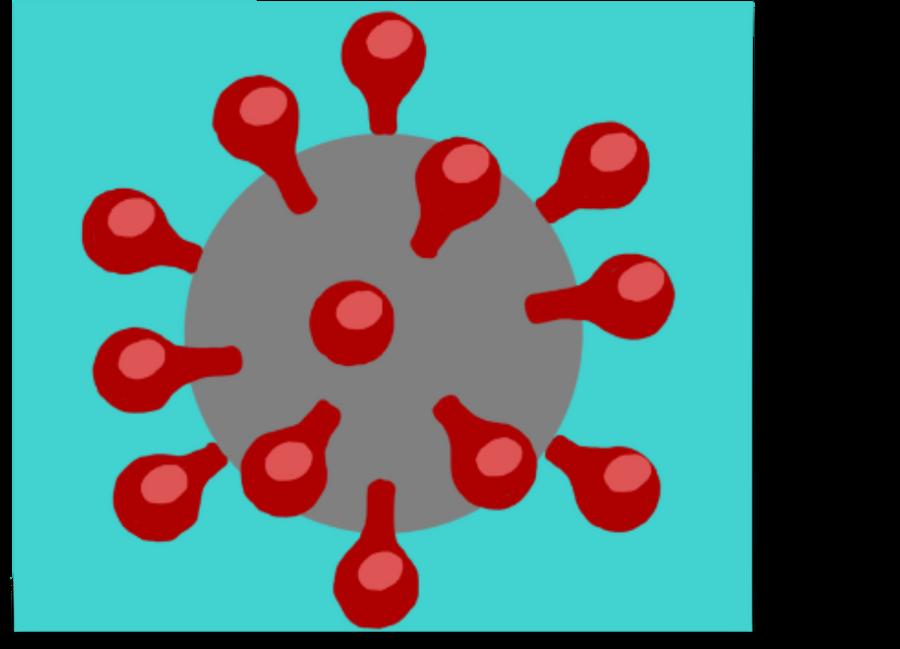
Theranostics, which combines medicines and diagnostics into a single product, is another exciting area of research Theranostic agents provide individualized and precise treatment techniques by concurrently diagnosing diseases and administering targeted medicines. The early diagnosis and treatment of numerous diseases, including cancer, offer enormous potential in this developing science.
Healthcare has been revolutionized by medical chemistry advances, which have enhanced our understanding of disease mechanisms Mapping the human genome, developing targeted medicines, and creating cutting-edge drug delivery methods have expanded the frontiers of medical innovation. Medical chemistry offers hope for better diagnoses, more efficient treatments, and ultimately a healthier future for everyone as we unravel the mysteries of the molecular world
The onset of the COVID-19 pandemic thrust countless universities and research institutions into a mad frenzy to be the first to find a cure for the virus. With more than 30 billion dollars funded by the US government alone, the whole world was demanding a swift and reliable antidote to be administered to the general public As a result, several companies took on the challenge to create, evaluate, and authorize a vaccine for emergency use in the shortest amount of time
Author: Brandon Oh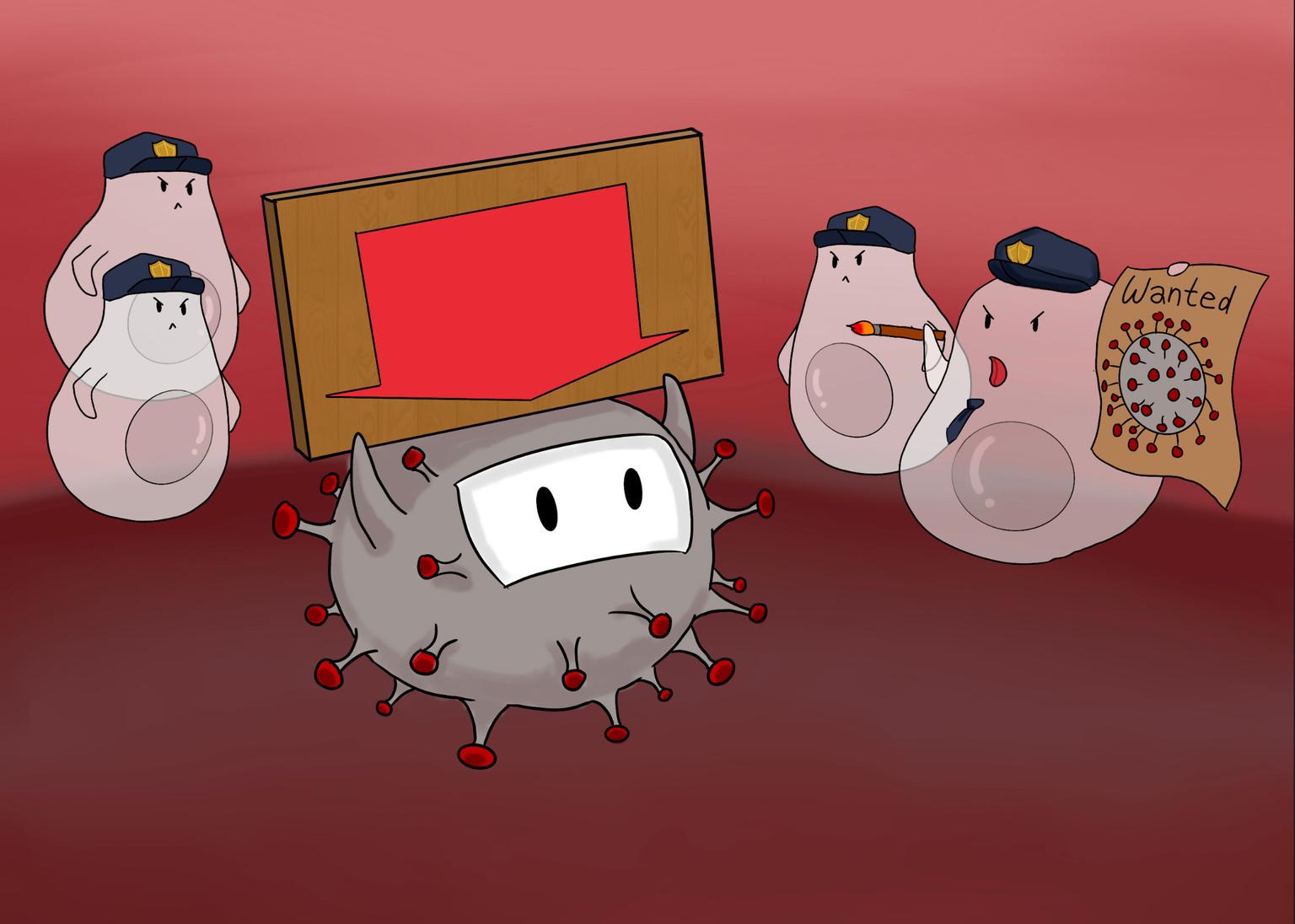
Editor: Sophia Chen and Joyce hai
Artist: Acey Li
As of July 2023, the World Health Organization reported the vaccinations of 5.5 billion individuals, with 13.4 billion doses administered. Despite these staggering numbers, most people still remain unfamiliar with the components of the vaccines. Many live under the false assumption that the actual COVID-19 virus was a prominent part of the vaccines, which is simply not true While some vaccines, such as those for measles, chicken pox, or yellow fever, require a weakened virus, the same cannot be said
for the COVID-19 vaccines. Instead, the vaccines developed by key pharmaceutical companies such as Pfizer, Novavax, and Johnson & Johnson each employed their own different strategies to create immunity against the virus
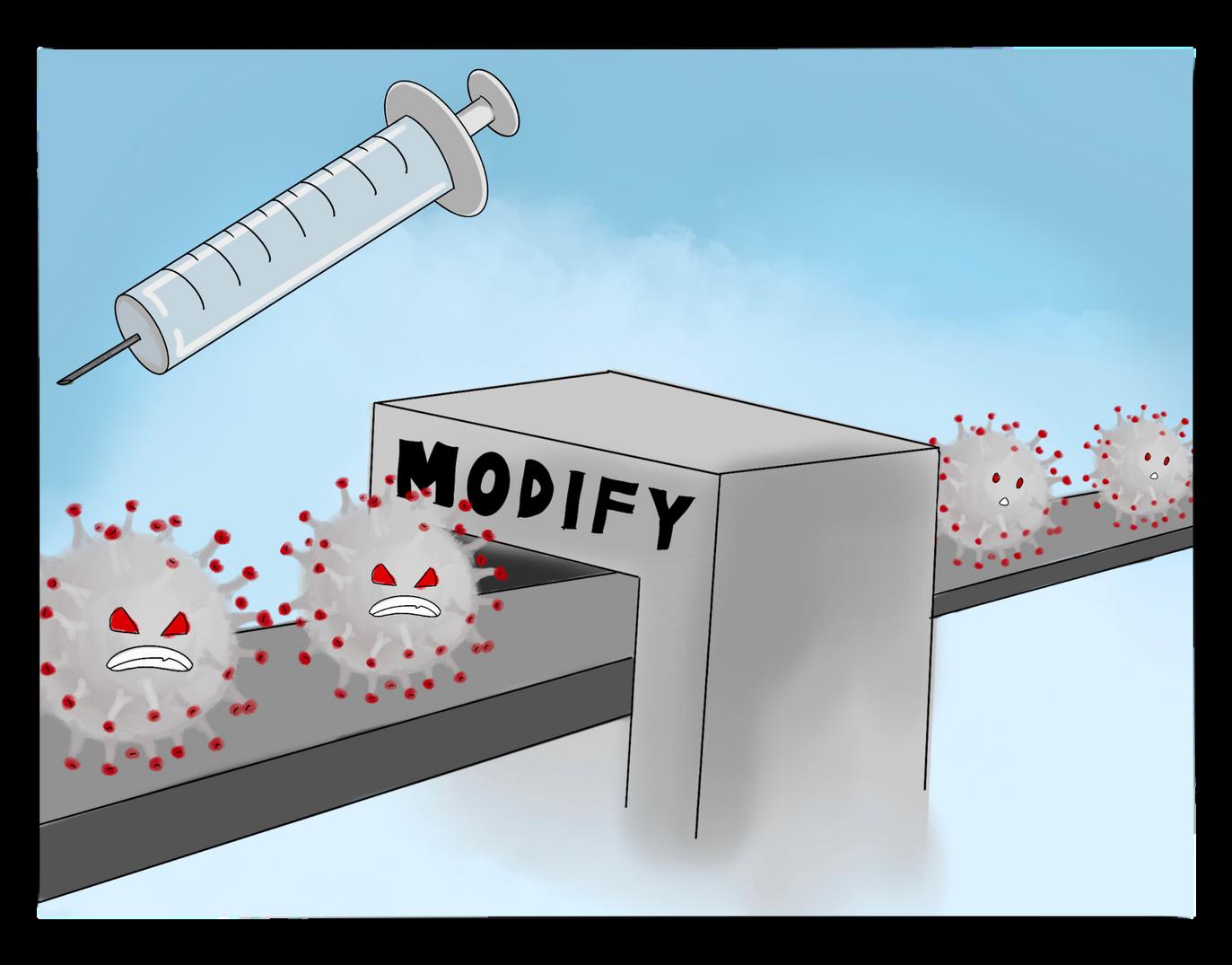
Messenger RNA Vaccine used by Pfizer and Moderna is a fairly modern technology. These Messenger RNA vaccines work by using a piece of mRNA (created in a laboratory) to make a protein found on the surface of the COVID-19 virus By doing so, the immune system recognizes the protein as a foreign object and produces antibodies to defend against it Antibodies help protect the body by identifying and attaching different viruses to them, marking them for extermination. Once produced, antibodies remain in the body even after the departure of the pathogen, allowing the immune system to respond if exposed again. Once the proteins are made, the mRNA is broken down by the cell and discarded Importantly, this process did not require the mRNA to enter the cell's nucleus, where the DNA resides
Viral vector vaccines created by Johnson & Johnson utilize a modified version of a virus (a vector), to deliver genetic instructions to the body’s cells Subsequently, the cells produce harmless versions of the virus called antigens, which then trigger an immune response in the body. The immune response creates antibodies and defensive white cells in the body that will later fight the virus when the body becomes exposed. One benefit of viral vector vaccines is their long-lasting immune responses - sometimes after a single dose
Subunit vaccines, a technique by Novavax, include only the antigens that most effectively stimulate the immune system. By including only the essential antigens in a vaccine, it is much less likely for adverse reactions to occur. This type of COVID-19 vaccine also includes an adjuvant ingredient that helps the immune system respond to the protein in the future As your immune system recognizes these proteins, it creates antibodies and white blood cells, preparing to defend against future viral attacks
chemistry’s healing touch
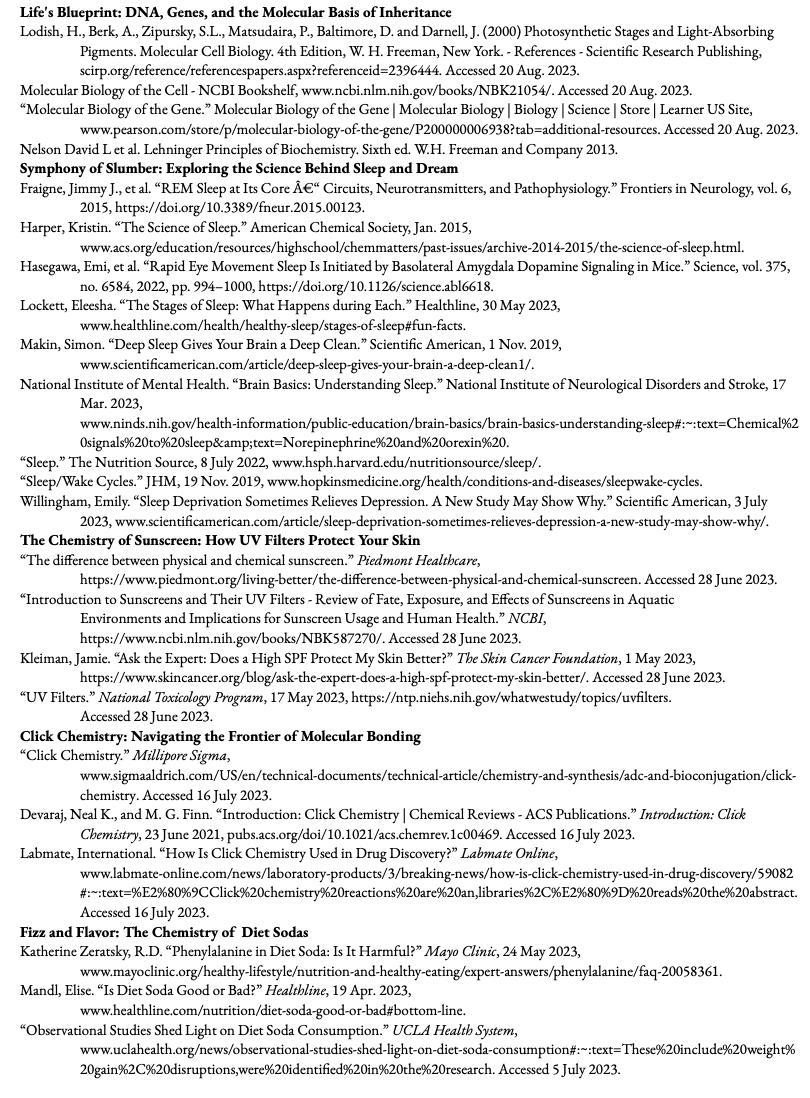


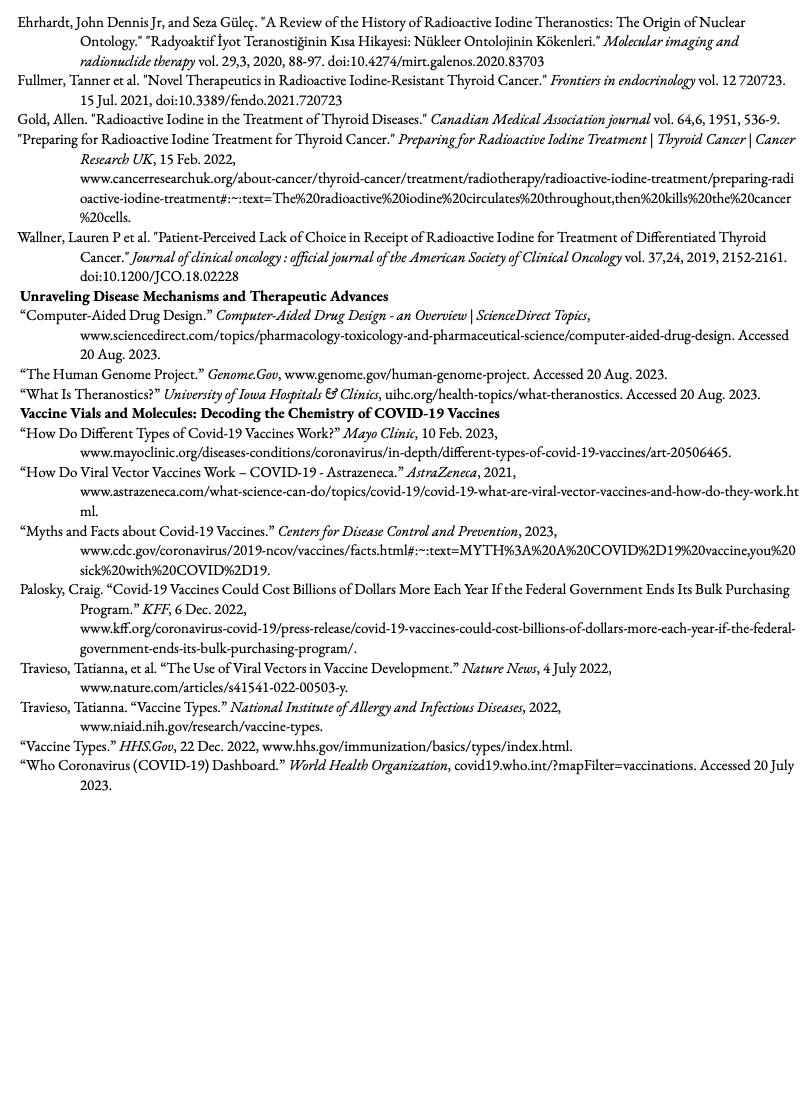
Whoarewelookingfor?
8th to 12th grade students who can commit for at least 2 hrs/week
English-speaking students globally
Interested in STEM
Whatarethebenefits?
Work in a student-led 501(c)3

nonprofit
Build your resume & gain volunteer hours and experience! Receive recommendation letters from your directors!
Ifinterested,pleaseviewourwebsiteformoreinformation!
Applicationisopenonourwebsitetoo~
Content Team
Writersareinchargeofproducinganarticleorblogina2-week window.
Blogs:~250-500words

Articles:~500-750words
Editorsareinchargeofediting1-2articlesorblogsina1-week window.
Edit4piecesofwritingpermonthintotal.
Art Team
Artistsareinchargeofdrawing3-4piecesofartforanarticleor blockina2-weekwindow.
SocialMediaMember:
create3-4socialmediacaptionseverymonthina2-week window
GraphicDesigners:
designthepostsforthecaptionsina2-weekwindow
Helpfindguestspeakers&judges
(forwebinars,conference,magazinepartnerships,fundraisers,& review)
sendout5-8emailsperweek
Website Team
HelpmaintainourWixwebsite
upload8-10articles/blogsina1-weekwindow
uploadeventrecordingsonthewebsite,YouTube&BiliBili
UpdatetheMembers'page&MemberoftheMonth RegulatetheDiscordserver
ScienceHolicisdedicatedtoenhancingteens'knowledgeofdifferent STEMfields.WestrivetointroducecomplicatedSTEMtopicsinamannerthat is both fun and comprehensible. We also provide various leadership opportunitiesforstudentsaroundtheworldandachancetoearnvolunteer hours.

ContributionstoScienceHolic,a501(c)(3)organization,aretaxdeductible.Sinceourorganizationrequirestheuseofvarioussuppliesfordaily operationandactivities,thisdonationpagehasbeencreatedtoraisefundsto invite top-tier professionals and professors working in the STEM fields: formattingourseasonalandspecial-themedmagazineeditionsand/orhelping maintainourwebsiteandposts.100%ofthefundscollectedwillgotowards supplyingourorganization.
Weareverygratefulforanypossiblecontributions—nomattertheamount andwouldliketothankanyonewhosupportsourcauseandorganization.To find out more about what we do, please go to our website (www.scienceholic.org), contact us through our email (scienceholicmagazine@gmail.com), or dm us on Instagram account (@scienceholicmag).
Thankyouagainforyoursupportandfortakingthetimetoreadour articles,blogs,andweeklyupdates;thisallmeanstheworldtous!Please considerdonatingtoScienceHolicandhelpteensfromallaroundtheworld gainmoreexposuretoSTEM!


